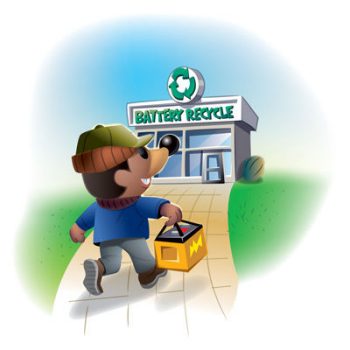By David S. Heroux
Look around, and you might notice that people use batteries every day in cars, smart watches, hearing aids, cellphones, and more! Batteries can allow us to use renewable energy sources and reduce pollution.
Most modern batteries, like those used in cell phones and electric cars, are reusable (or rechargeable). They can be charged and used over and over until they wear out and no longer work. When that happens, we need to recycle them. Recycling is a process for changing old, worn-out things into new, reusable parts or devices. Almost all batteries are recyclable, either entirely or in part.

Lead-acid batteries
Cars that run on gasoline have the oldest type of rechargeable batteries, called lead-acid batteries. They are used for starting the car and operating the lights, radio, and other accessories. Lead-acid batteries provide energy, but they are also big and bulky, and have a limited life span. Fortunately, lead-acid batteries are fairly easy to recycle. Many stores that sell new batteries will take used ones in exchange.
Lead-acid batteries have heavy plastic containers that hold lead and lead compounds, surrounded by acid. To recycle these batteries, the acid must be neutralized, and then the whole battery is crushed up. Crushed parts are put in water: plastic parts float up and lead parts sink. Plastic parts are first separated, and then recycled into new battery containers. The lead parts can be melted and recycled into new batteries. Over 99% of lead-acid batteries today are recycled, and new batteries are made from 60-80% recycled lead and plastic.
Alkaline batteries
Most common household devices, such as remote controls, flashlights, and radios, run on alkaline batteries. This type of battery is often not rechargeable and can only be used once. Certain parts of alkaline batteries are recyclable—but currently, less than half are.
Inside alkaline batteries are zinc (Zn) and manganese (Mn), two types of metal that can be recycled. The casing is made of steel, which can be recycled multiple times. First, the batteries are cut up and crushed. Then, after an electric current is used to separate the parts, the Zn and Mn can be recycled into new batteries. Some companies are trying to make plant fertilizers from them.
Lithium-ion batteries
Cellphones, bicycles, hearing aids, and electric cars all use lithium-ion batteries (or LIBs, for short). These can be charged again and again. They can be made in various shapes and sizes and can be quite powerful.
LIBs can also be recycled, but only about 5% are. This may be because LIBs are harder to recycle. They contain parts that are made of different metals including lithium (Li), cobalt (Co), and nickel (Ni). Some of these parts can be dangerous to people, and they need to be handled with caution. Currently the biggest challenge is finding a cost-effective method to recycle them.
Every year, more and more bikes, cars, trucks, and even planes are using LIBs. Scientists and engineers are working to find better ways to recycle and reuse these batteries, and at the same time, reduce waste. Some scientists are even developing robots to separate the parts and make recycling easier and safer.
Perhaps, one day, you will be a scientist or engineer who helps develop a safer and less expensive way to recycle batteries and all their parts!
David S. Heroux is the Leavy Family Professor of Chemistry at Saint Michael’s College in Colchester, Vermont.

